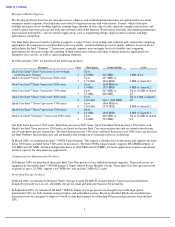Intel 2006 Annual Report Download - page 21
Download and view the complete annual report
Please find page 21 of the 2006 Intel annual report below. You can navigate through the pages in the report by either clicking on the pages listed below, or by using the keyword search tool below to find specific information within the annual report.
Table of Contents
We continue to be largely dependent on the success of our microprocessor business. Our ability to compete depends on our
ability to deliver new microprocessor products with improved overall performance and/or improved energy-efficient
performance at competitive prices. Many of our competitors, including Advanced Micro Devices, Inc. (AMD), our primary
microprocessor competitor, market software-compatible products that compete with our processors. We also face competition
from companies offering rival microarchitecture designs, such as Cell Broadband Engine Architecture developed jointly by
International Business Machines Corporation (IBM), Sony Corporation, and Toshiba Corporation. Our desktop processors
compete with products offered by AMD, IBM, and VIA, among others. Our mobile microprocessor products compete with
products offered by AMD, IBM, Transmeta Corporation, and VIA, among others. Our server processors compete with
software-compatible products offered by AMD and with products based on rival architectures, including the Service-Oriented
Architecture (SOA) offered by IBM and the Scalable Processor Architecture (SPARC*) offered by Sun Microsystems, Inc.
Our chipsets compete in the various market segments against different types of chipsets that support either our microprocessor
products or rival microprocessor products. Competing chipsets are produced by companies such as ATI Technologies, Inc.
(recently acquired by AMD), NVIDIA, Silicon Integrated Systems Corporation (SIS), and VIA. We also compete with
companies offering graphics components and other special-purpose products used in the desktop, mobile, and server market
segments. One aspect of our business model is to incorporate improved performance and advanced properties into our
microprocessors and chipsets, the demand for which may increasingly be affected by competition from companies, such as
NVIDIA, whose business models are based on incorporating improved performance into dedicated chipsets and other
components, such as graphics controllers.
Our NOR and NAND flash memory products currently compete with the products of other companies, such as Hynix
Semiconductor Inc., Micron, Samsung Electronics Co., Ltd., Spansion Inc., STMicroelectronics NV, and Toshiba.
We offer products designed for wired and wireless connectivity; for the communications infrastructure, including network
processors; and for networked storage. These products currently compete against offerings from companies such as Applied
Micro Circuits Corporation, AMD, Broadcom, Freescale Semiconductor, Inc., IBM, OpNext, Inc., Sun Microsystems, and
VIA.
We also offer platforms for the desktop, mobile, and server market segments that integrate components that enable targeted
usage models. We believe that our platform offerings give us a competitive advantage. Our platforms are designed to meet the
specific needs of end users and are optimized to deliver increased security and manageability, energy-efficient performance,
and other innovative solutions embedded into our microprocessors. With AMD’s acquisition of ATI Technologies, we
anticipate increased platform competition in various market segments.
Acquisitions and Strategic Investments
During 2006, the company did not complete any acquisitions qualifying as business combinations. In 2006, Intel formed
IMFT, a NAND flash memory manufacturing company, with Micron. Intel invested $1.3 billion in return for a 49% interest.
See “Note 17: Venture” in Part II, Item 8 of this Form 10-K. Also during 2006, Intel paid $600 million for an investment in
Clearwire Corporation. Clearwire builds and operates next-generation wireless broadband networks. See “Note 7:
Investments” in Part II, Item 8 of this Form 10-K.
Intellectual Property and Licensing
Intellectual property rights that apply to our various products and services include patents, copyrights, trade secrets,
trademarks, and maskwork rights. We maintain an active program to protect our investment in technology by attempting to
ensure respect for our intellectual property rights. The extent of the legal protection given to different types of intellectual
property rights varies under different countries’ legal systems. We intend to license our intellectual property rights where we
can obtain adequate consideration. See “Competition” in Part I, Item 1 of this Form 10-K; “Legal Proceedings” in Part I, Item
3 of this Form 10-K; and “Risk Factors” in Part I, Item 1A of this Form 10-K.
13
























